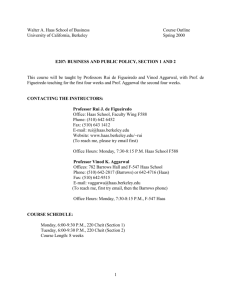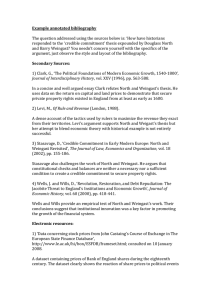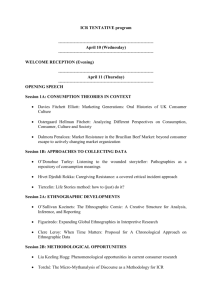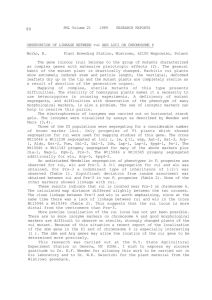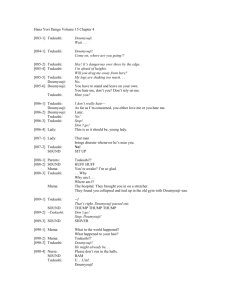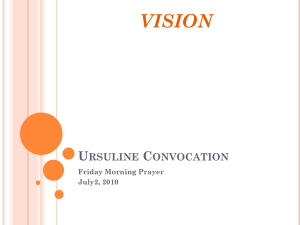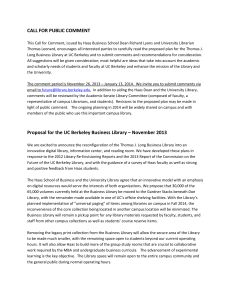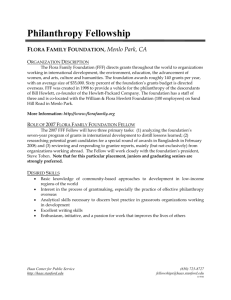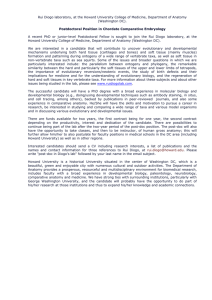Syllabus - University of California, Berkeley
advertisement
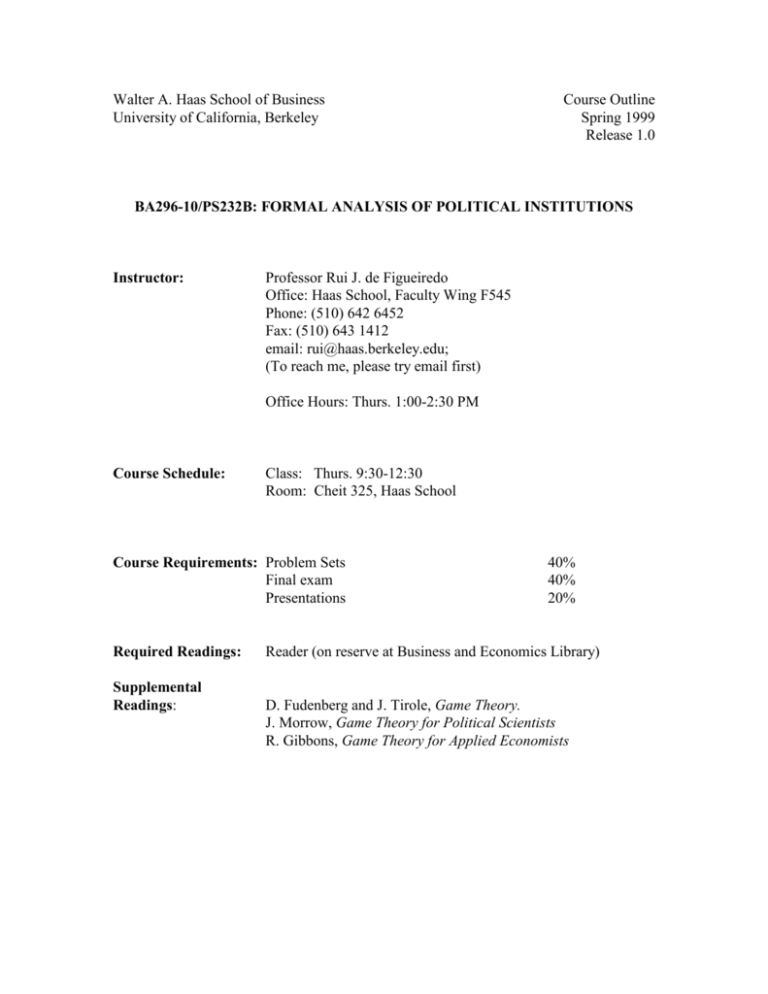
Walter A. Haas School of Business University of California, Berkeley Course Outline Spring 1999 Release 1.0 BA296-10/PS232B: FORMAL ANALYSIS OF POLITICAL INSTITUTIONS Instructor: Professor Rui J. de Figueiredo Office: Haas School, Faculty Wing F545 Phone: (510) 642 6452 Fax: (510) 643 1412 email: rui@haas.berkeley.edu; (To reach me, please try email first) Office Hours: Thurs. 1:00-2:30 PM Course Schedule: Class: Thurs. 9:30-12:30 Room: Cheit 325, Haas School Course Requirements: Problem Sets Final exam Presentations Required Readings: Supplemental Readings: 40% 40% 20% Reader (on reserve at Business and Economics Library) D. Fudenberg and J. Tirole, Game Theory. J. Morrow, Game Theory for Political Scientists R. Gibbons, Game Theory for Applied Economists Prof. Rui de Figueiredo E207 Syllabus, Fall 1997 2 BA296-10/PS232B: FORMAL ANALYSIS OF POLITICAL INSTITUTIONS Course Overview BA296-10/PS232B is a continuation of PS232A. The objective of this course is to deepen students’ understanding of and prepare students to conduct research using formal models. The substantive focus of the course is on collective choice in the context of political institutions including legislative institutions, electoral institutions, parliamentary governments, bureaucracies, federal systems, and international systems. The methodological focus of the course is on the application of formal models, and primarily game theoretic models, to study these institutions. The course format is designed around close readings of recent important papers using these methods to study political institutions. The intention is to go through each paper’s models at a level of granularity so that students can understand the nature of the research process behind the development of the paper. The prerequisites for the class are PS232A, an equivalent course in game theory, or permission of the instructor. In addition, a number of useful texts on game theory are available from the book store. The course requirements are a number of problem sets, presentation of one of the papers, and a final exam. The reading list follows. Readings are on reserve at the Haas School Library. Prof. Rui de Figueiredo E207 Syllabus, Fall 1997 3 BA296-10 and PS232B: FORMAL ANALYSIS OF POLITICAL INSTITUTIONS Tentative Schedule for Readings and Discussions AMERICAN LAWMAKING INSTITUTIONS Introduction T. Romer and H. Rosenthal, “Political Resource Allocation, Controlled Agendas, and the Status Quo,” Public Choice 33 (1978): 27-43. K. Shepsle, “Institutional Arrangements and Equilibrium Institutions,” American Journal of Political Science 23:1 (1979): 27-59. Cox, Gary W. “Electoral Equilibrium under Alternative Voting Institutions,” American Journal of Political Science 31 (1987): 82-108. B. Weingast, “A Rational Choice Perspective on Congressional Norms,” American Journal of Political Science 23 (1979): 245-262. Bargaining Models D. Baron and J. Ferejohn, “Bargaining in Legislatures,” American Political Science Review 83:4 (December 1989): 1181. D. Baron, “Majoritarian Incentives, Pork Barrel Programs and Procedural Control,” American Journal of Political Science 35:1 (1991): 57-90. D. Baron, “Electoral Competition with Informed and Uninformed Voters,” American Political Science Review 88:1 (March 1994): 33. Organization of Legislatures K. Shepsle and B. Weingast, “The Institutional Foundations of Committee Power,” American Political Science Review 81 (1987): 85. T. Gilligan and K. Krehbiel, “Collective Decision-making and Standing Committees: An Informnational Rationale for Restrictive Amendment Procedures,” Journal of Law, Economics and Organization 3: (1987): 287. D. Austen-Smith, “Information and Influence: Lobbying for Agendas and Votes,” American Journal of Political Science 37 (1993): 799-833. D. Diermeier, “Commitment, Deference and Legislative Institutions”, American Political Science Review 89 (1995): 344-355. Vote Buying Models J. Snyder, “On Buying Legislatures,” Economics and Politics (1991). T. Groseclose and J. Snyder, “Buying Supermajorities,” American Political Science Review 90:2 (1993): 303. Prof. Rui de Figueiredo E207 Syllabus, Fall 1997 4 Modelling more than One House S. Matthews, “Veto Threats: Rhetoric in A Bargaining Game,” Quarterly Journal of Economics 104 (1989): 347-369. D. Ingberman and D. Yao, “Presidential Commitment and the Veto,” American Journal of Political Science 35 (1991): 357-389. K. Krehbiel, “Institutional and Partisan Sources of Grislock: A Theory of Divided and Unified Government,” Journal of Theoretical Politics 8 (1996): 7-40. MODELS OF INTEREST GROUPS, LOBBYING AND BUREAUCRACY Snyder, James M, “Election goals and the Allocation of Campaign Resources,” Econometrica 57:3 (May 1989):637. D. Austen-Smith and J. Wright, “Counteractive Lobbying,” Journal of Social Choice and Welfare (1992). J. Banks, “Agency Budgets, Cost Information and Auditing,” American Journal of Political Science 33 (1989): 670-699. D. Epstein and Sharyn O’Halloran, “Administrative Procedures, Information and Agency Discretion,” American Journal of Political Science 38 (1994): 697-722. J. Banks and B. Weingast, “The Political Control of Bureaucracies under Asymmetric Information,” American Journal of Political Science 36:2 (1992): 509. J. Bendor, S. Taylor, and R. Van Gaalen, “Politicians, Bureaucrats and Asymmetric Information,” American Journal of Political Science (1987): 796-828. O. Williamson, “Private and Public Bureaus,” manuscript, 1997. O. Williamson, “Comparative Economic Organization: The Analysis of Disrete Structural Alternatives, ” Administrative Science Quarterly (1991): 269-296. MODELS OF HIERARCHIES J. Bendor and D. Mookherjee, “Institutional Structure and the Logic of Ongoing Collective Action,” American Political Science Review 81:1 (March 1987): 129. T. Persson and G. Tabellini, “Federal Fiscal Constitutions: Risk Sharing and Moral Hazard,” Econometrica 64:3 (May 1996): 623. R. de Figueiredo and B. Weingast, “Self-Enforcing Federalism: Solving the Two Fundamental Dilemmas,” manuscript, 1997. MODELS OF VOTING T. Feddersen and W. Pessendorfer, “The Swing Voter’s Curse,” American Economic Review 86:3 (1996): 408-424. D. Austen-Smith and J. Banks, “Information Aggregation, Rationality, and the Condorcet Jury Theorem,” American Political Science Review 90, n1 (March 1996): 34. T. Feddersen and W. Pessendorfer, “Convicting the Innocent: The Inferiority of Unanimous Jury Verdicts Under Strategic Voting,” American Political Science Review 92:1 (1998): 23-35. Prof. Rui de Figueiredo E207 Syllabus, Fall 1997 5 MODELS OF PARLIAMENTARY SYSTEMS D. Baron, “A Spatial Bargaining Theory of Government Formation in Parliamentary Systems,” American Political Science Review 85:1 (March 1991): 137. D. Austen-Smith and J. Banks, “Elections, Coalitions, and Legislative Outcomes,” American Political Science Review 82:2 (June 1988): 405. M. Laver and K. Shepsle, “Coalitions and Cabinet Government,” American Political Science Review 84:3 (September 1990): 873. D. Diermeier and T. Feddersen, “Cohesion in Legislatures and the Vote of Confidence Procedure,” American Political Science Review 92 (1998): 611-621. MODELS OF INTERNATIONAL RELATIONS J. Fearon, “Rationalist Explanations for War,” International Organization 49:3 (1995): 379414. J. Fearon and D. Laitin, “Explaining Interethnic Cooperation,” American Political Science Review 90:4 (1996): 715-735. R. Powell, “Brgaining in the Shadow of Power,” Games and Economic Behavior 15 (1996): 255-289. G. Downs and D. Rocke, “Conflict, Agency and Gambling for Resurrection: The PrincipalAgent Problem Goes to War,” American Journal of Political Science 38 (1994): 362-380.
